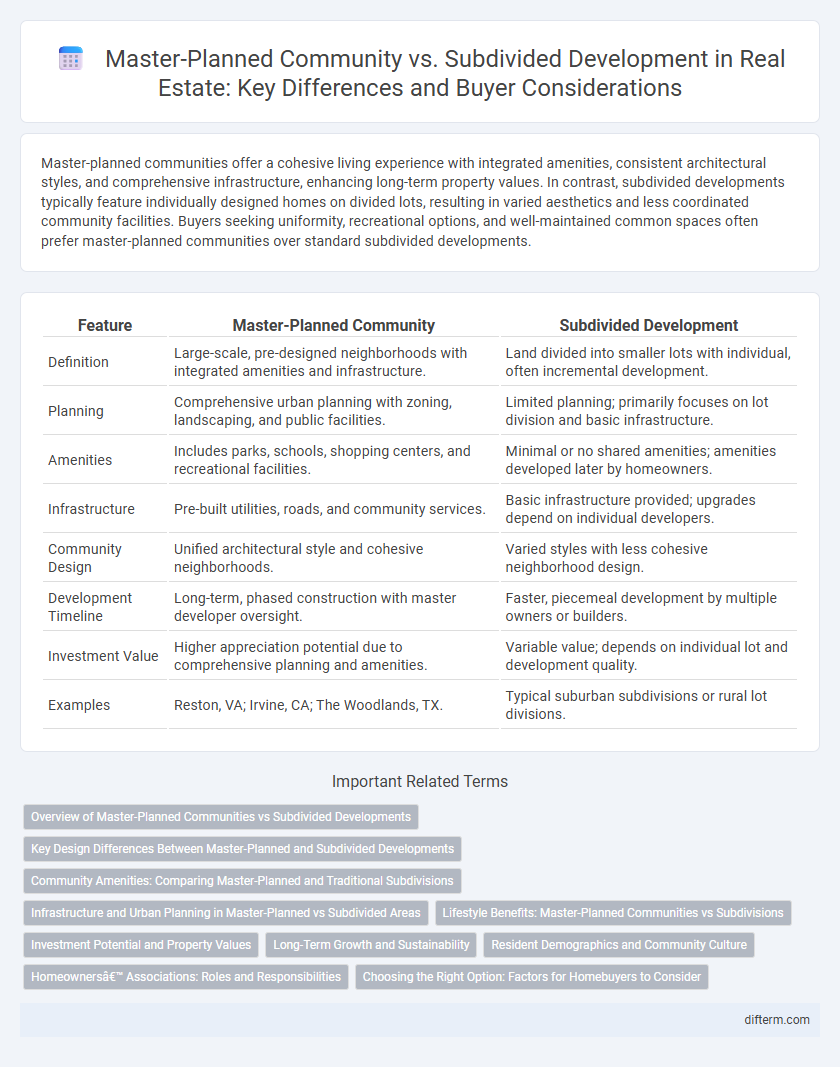Master-planned communities offer a cohesive living experience with integrated amenities, consistent architectural styles, and comprehensive infrastructure, enhancing long-term property values. In contrast, subdivided developments typically feature individually designed homes on divided lots, resulting in varied aesthetics and less coordinated community facilities. Buyers seeking uniformity, recreational options, and well-maintained common spaces often prefer master-planned communities over standard subdivided developments.
Table of Comparison
| Feature | Master-Planned Community | Subdivided Development |
|---|---|---|
| Definition | Large-scale, pre-designed neighborhoods with integrated amenities and infrastructure. | Land divided into smaller lots with individual, often incremental development. |
| Planning | Comprehensive urban planning with zoning, landscaping, and public facilities. | Limited planning; primarily focuses on lot division and basic infrastructure. |
| Amenities | Includes parks, schools, shopping centers, and recreational facilities. | Minimal or no shared amenities; amenities developed later by homeowners. |
| Infrastructure | Pre-built utilities, roads, and community services. | Basic infrastructure provided; upgrades depend on individual developers. |
| Community Design | Unified architectural style and cohesive neighborhoods. | Varied styles with less cohesive neighborhood design. |
| Development Timeline | Long-term, phased construction with master developer oversight. | Faster, piecemeal development by multiple owners or builders. |
| Investment Value | Higher appreciation potential due to comprehensive planning and amenities. | Variable value; depends on individual lot and development quality. |
| Examples | Reston, VA; Irvine, CA; The Woodlands, TX. | Typical suburban subdivisions or rural lot divisions. |
Overview of Master-Planned Communities vs Subdivided Developments
Master-planned communities are large-scale residential areas with integrated amenities such as parks, schools, retail centers, and recreational facilities, designed to create a self-sustaining living environment. Subdivided developments primarily involve dividing land into smaller lots for residential construction, often lacking the comprehensive infrastructure and community features found in master-planned projects. The strategic planning of master-planned communities aims to enhance quality of life, property values, and long-term growth, whereas subdivided developments typically focus on maximizing parcel sales with limited shared public spaces.
Key Design Differences Between Master-Planned and Subdivided Developments
Master-planned communities integrate residential, commercial, and recreational spaces into a cohesive environment, emphasizing long-term urban design, comprehensive amenities, and infrastructure coordination. Subdivided developments primarily focus on parceling land into individual lots for residential use, often lacking centralized planning for community facilities and shared public spaces. The key design difference lies in master-planned developments offering holistic lifestyle planning with mixed-use zoning, while subdivided developments concentrate on maximizing residential density and lot segmentation.
Community Amenities: Comparing Master-Planned and Traditional Subdivisions
Master-planned communities offer extensive community amenities such as parks, recreational centers, golf courses, and schools, designed to enhance resident lifestyle and promote social interaction. Traditional subdivided developments typically provide fewer shared amenities, focusing primarily on individual lot sales with limited communal spaces. The integrated planning in master-planned communities fosters higher property values and a cohesive neighborhood environment compared to the segmented approach of standard subdivisions.
Infrastructure and Urban Planning in Master-Planned vs Subdivided Areas
Master-planned communities feature comprehensive infrastructure with integrated utilities, roads, parks, and community amenities designed through strategic urban planning, ensuring cohesive development and long-term sustainability. Subdivided developments often rely on piecemeal infrastructure additions, leading to potential inconsistencies in road layouts, utility access, and limited public spaces. The coordinated approach in master-planned areas enhances property value and livability by prioritizing efficient transportation networks and environmental management from inception.
Lifestyle Benefits: Master-Planned Communities vs Subdivisions
Master-planned communities offer integrated lifestyle benefits through amenities such as parks, recreational centers, and shopping areas designed to foster social interaction and convenience. Subdivided developments often lack these cohesive features, resulting in fewer communal spaces and limited access to shared facilities. Residents in master-planned communities experience enhanced security, walkability, and well-maintained environments that promote a higher quality of life.
Investment Potential and Property Values
Master-planned communities often offer higher investment potential due to their comprehensive amenities, infrastructure, and long-term development strategies that enhance property values over time. Subdivided developments typically involve smaller-scale projects with fewer shared facilities, which can result in more variable property appreciation and limited appeal to investors. Market data consistently shows master-planned communities outperform subdivided developments in stability and growth of property values.
Long-Term Growth and Sustainability
Master-planned communities offer long-term growth through integrated infrastructure and cohesive design, promoting sustainable living environments with extensive amenities and green spaces. Subdivided developments often prioritize immediate sales over strategic expansion, potentially limiting future appreciation and community resilience. Sustainable growth in real estate favors master-planned projects due to their comprehensive planning and environmental considerations.
Resident Demographics and Community Culture
Master-planned communities typically attract diverse resident demographics seeking integrated amenities, comprehensive services, and long-term lifestyle stability, fostering a cohesive and engaged community culture. Subdivided developments often draw buyers focused on individual property ownership with varying priorities, resulting in a less unified community atmosphere and more heterogeneous resident profiles. Understanding these dynamics informs developers and investors about social cohesion, resident retention, and neighborhood identity factors.
Homeowners’ Associations: Roles and Responsibilities
Homeowners' Associations (HOAs) in master-planned communities typically oversee extensive amenities, enforce comprehensive rules, and manage community-wide maintenance to preserve property values. In subdivided developments, HOAs generally handle more limited responsibilities focused on common area upkeep and basic covenant enforcement. Understanding these distinctions helps residents navigate governance structures and anticipate their obligations and benefits in each type of development.
Choosing the Right Option: Factors for Homebuyers to Consider
Homebuyers should evaluate community amenities, long-term maintenance plans, and governance structures when deciding between a master-planned community and a subdivided development. Master-planned communities often offer integrated facilities like parks, schools, and retail centers, enhancing lifestyle convenience and property value stability. Subdivided developments may provide more customization control and potentially lower initial costs but typically lack cohesive amenities and long-term management frameworks.
master-planned community vs subdivided development Infographic

 difterm.com
difterm.com